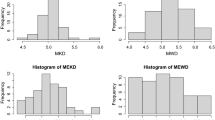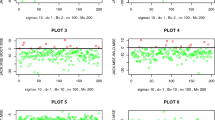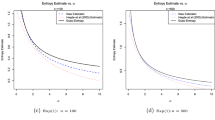Abstract
The identification of the input to, or kernels of, a system using nonparametric representations and least-squares estimation is becoming increasingly popular. Nonparametric representations avoid making a priori assumptions about the input or having detailed knowledge about the system, and only need to guarantee known general characteristics (for example, positivity), which are obtained through the imposition of constraints on the estimates. An often overlooked problem is how to characterize the variability of the estimates so obtained. This problem is caused by the presence of constraints—and/or the nonlinearities of the estimates, or the complexity of the (regression based) estimation algorithms used—which make standard methods of estimating variability incorrect. In this article we investigate the use of a resampling technique called the “bootstrap” to obtain the desired estimates of variability. We present real data analysis demonstrating the approach, and through simulations we test the performance of a novel bootstrap technique obtaining confidence bands for the estimated functions. © 1998 Biomedical Engineering Society.
PAC98: 8710+e, 0270Lq
Similar content being viewed by others
REFERENCES
Akaike, H. A new look at the statistical model identification problem. IEEE Trans. Autom. Control.19:716-723, 1974.
Belsley, D. A. Conditioning Diagnostic. New York: Wiley, 1991.
Cobelli, C., and K. Thomaseth. On optimality of the impulse input for linear system identification. Math. Biosci.89:127- 133, 1988.
DeBoor, C. A Practical Guide to Splines. New York: Springer, 1978.
Efron, B. Bootstrap methods: Another look at the jacknife. Ann. Statist.4:1-26, 1976.
Efron, B. The Jackknife, The Bootstrap and Other Resampling Planes. Philadelphia: Society for Industrial and Applied Mathematics, 1982.
Goussard, Y. Wiener Kernel estimation: A comparison of cross-correlation and stochastic approximation methods. Ann. Biomed. Eng.16:289-301, 1988.
Hall, P. The Bootstrap and Edgeworth Expansion. New York: Springer, 1992.
Hastie, T. J., and R. J. Tibshirani. Generalized Additive Models, Monographs on Statistics and Applied Probability. New York: Chapman and Hall, 1990, Vol. 43.
Iga, K., Y. Ogawa, T. Yashiki, and T. Shimamoto. Estimation of drug absorption rates using a deconvolution method with nonequal sampling times. J. Pharmacokinet. Biopharm.14:213-225, 1986.
Kaumeier, H. S., O. H. Kehrhahn, G. Neugebauer, D. Shuppan, J. A. Shwarz, and A. H. Staib. A crossover study after oral administration of theophylline in male volunteers (Absolute bioavailability of afonilum tablets). Int. J. Clin. Pharmacol., Ther. Toxicol.21:339-345, 1983.
Marmarelis, V. Z. Identification of nonlinear biological systems using Laguerre expansions of kernels. Ann. Biomed. Eng.21:573-589, 1993.
Mukerjee, H., and T. Renjin. Order restricted inferences in linear regression. J. Am. Stat. Assoc.90:717-728, 1995.
Muller, H. G. Nonparametric regression analysis of longitudinal data. In: Lectures Notes in Statistics. New York: Springer, 1988.
Plusquellec, Y., G. Campistron, J. Barre, L. Jung, J. P. Tillement, and G. Houin. A double-peak phenomenon in the pharmacokinetics of veralipride after oral administration: A double-site model for drug absorption. J. Pharmacokinet. Biopharm.15:225-239, 1987.
Provencher, S. W., and R. H. Vogel. In: Numerical Treatment of Inverse Problems in Differential and Integral Equations, edited by P. Deuflhard and E. Hairer. Boston: Birkhauser, 1983.
Stine, R. A. Bootstrap prediction intervals for regression. J. Am. Stat. Assoc.80:1026-1031, 1985.
Verotta, D. Dept. of Biostatistics, University California Berkeley: PhD dissertation, Chap. 3, University Microfilms International, 1992.
Verotta, D. Concepts, properties, and applications of linear systems to describe the distribution, identify input, and control endogenous substances and drugs in biological systems. Crit. Rev. Biomed. Eng.24:73-139, 1996.
Verotta, D. Deconvolution. Anaesth. Pharmacol. Rev.2:250- 259, 1994.
Verotta, D. Estimation and model selection using splines in constrained deconvolution. Ann. Biomed. Eng.21:605-620, 1993.
Wahba, G. In: Statistical Decision Theory and Related Topics III, edited by S. S. Gupta and J. O. Berger. New York: Academic, 1982, Vol. 2. pp. 383-418.
Wahba, G. Spline Models for Observational Data. Philadelphia: Society for Industrial and Applied Mathematics, 1990.
Working, H., and H. Hotelling. Application of the theory of error to the interpretation of trends. J. Am. Stat. Assoc.24:73-85, 1929.
Author information
Authors and Affiliations
Rights and permissions
About this article
Cite this article
Verotta, D. Characterizing the Variability of System Kernel and Input Estimates. Annals of Biomedical Engineering 26, 870–882 (1998). https://doi.org/10.1114/1.110
Issue Date:
DOI: https://doi.org/10.1114/1.110




